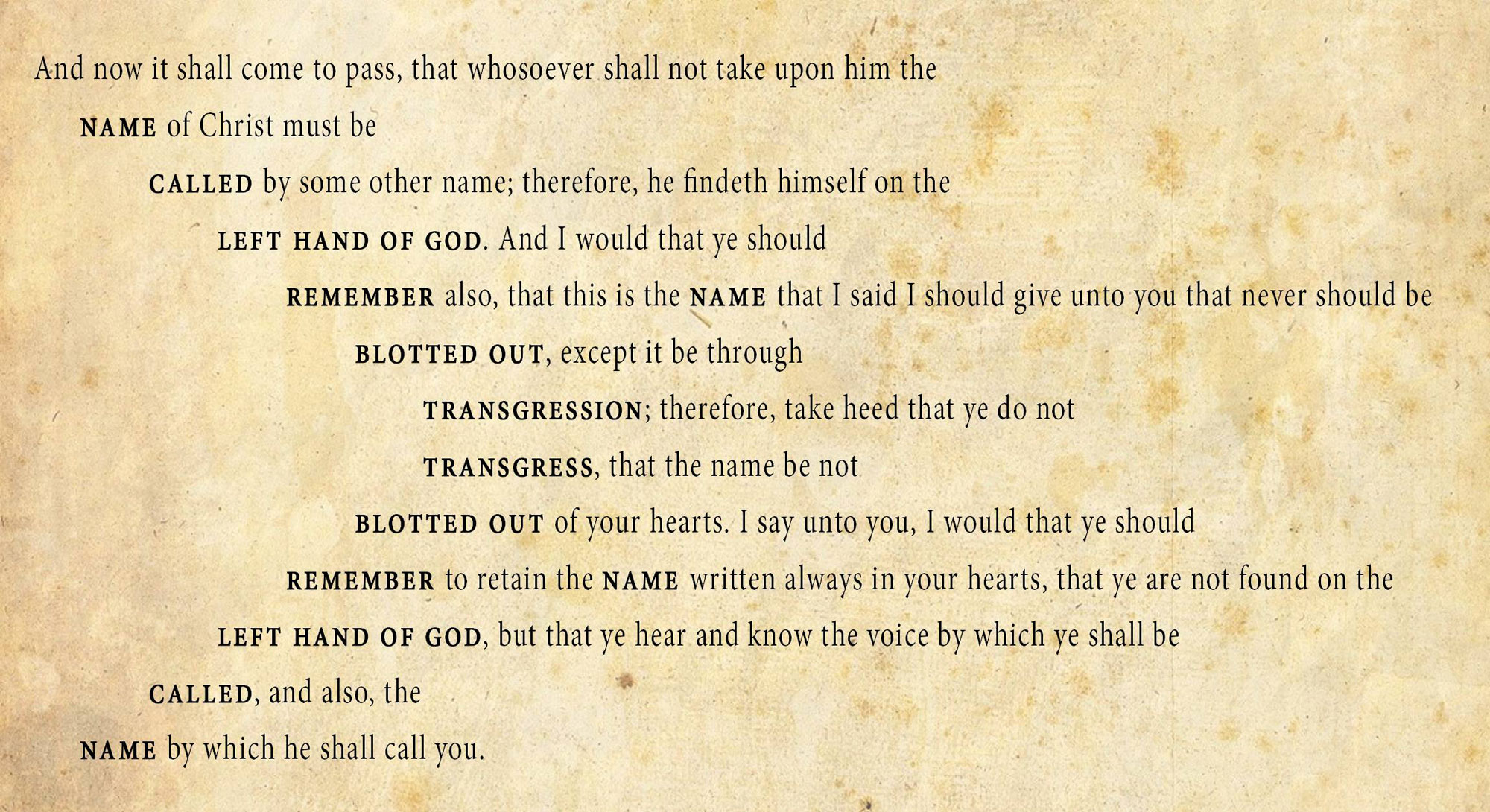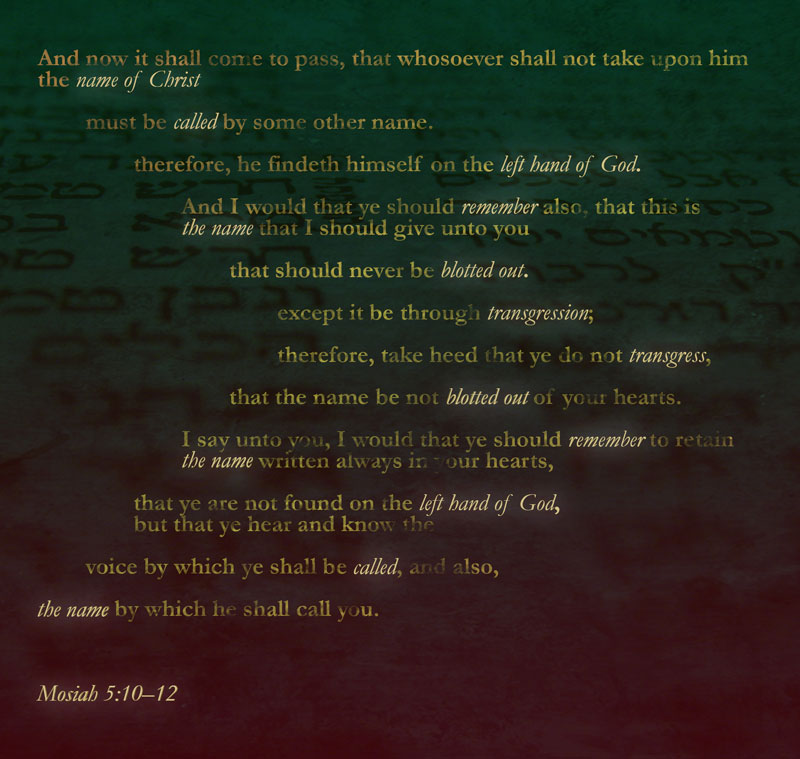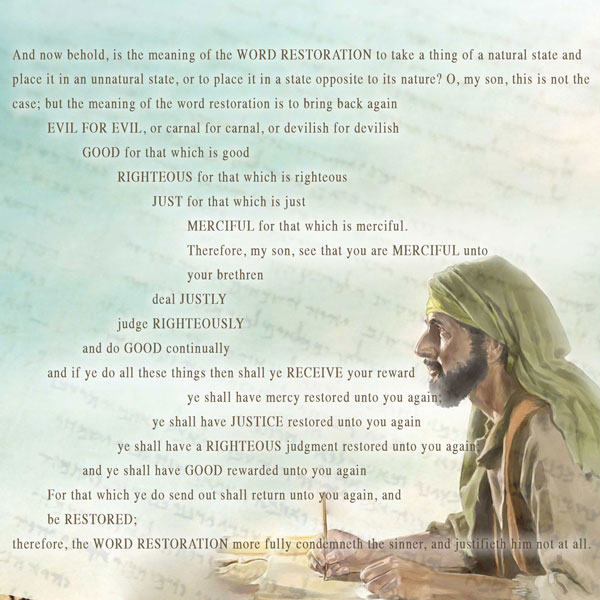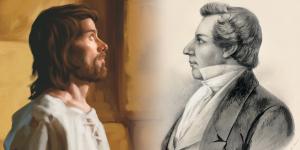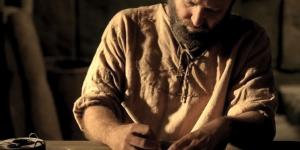You are here
Why Is the Presence of Chiasmus in the Book of Mormon Significant?

Mosiah 5:10–12
The Know
The discovery of chiasmus in the Book of Mormon is one of the most significant scholarly contributions to understanding and appreciating the Nephite record.1 John W. Welch discovered the presence of chiasmus on August 16, 1967 while on his mission in Germany.2 Since that time, a steady stream of publications since that time has thrown much light on this matter.3
Chiasmus is a structural form that has been used in both poetry and prose for thousands of years in a variety of cultures and languages. “Chiasmus can be defined most simply as an inverted type of parallelism.”4 A parallelism is a literary technique where “the component elements of one line correspond directly to those of the other in a one-to-one relationship.”5 For example, a verse in the Psalms reads, “As a father has compassion on his children, so the Lord has compassion on those who fear him” (NIV Psalm 103:13). Parallelisms are a ubiquitous feature in ancient Hebrew texts.
Chiasmus (named after the Greek letter chi, χ) is a form of inverted parallelism where the elements are ordered and then repeated in reverse (a-b-b-a). Chiasms can be simple or complex, and can be structured along both vocabulary or thematic elements. A scripture well-known to Latter-day Saints is a good example of a simple chiasm:
(A) And he shall turn the heart of the fathers
(B) to the children,
(B’) and the heart of the children
(A’) to their fathers.
Malachi 4:6
Chiasmus (as well as other forms of parallelism) appears throughout the entirety of the Book of Mormon, both in prose and poetic passages.6 One of the chiastic passages Welch initially discovered occurs in King Benjamin’s speech in Mosiah 5.7 In this passage “King Benjamin is interested in contrasting those who remember the covenantal name with those who do not, or contrasting those who know the voice by which they will be called with those who must be called by some other name.”8
Not only individual verses but whole chapters and even entire books in the Book of Mormon are structured as chiasms.9 For example, Alma 36 is structured as an intricate chiasm with Jesus Christ as its central focus.10
The Why
Understanding the use of chiasmus in the Book of Mormon can benefit readers in many ways. First, chiasmus in the Book of Mormon demonstrates that the text is orderly, complex, rich, and aesthetically pleasing. “The presence of chiasmus in the English text of the Book of Mormon supplies significant evidence that the book is more beautiful than people had previously thought.”11 It deserves to be paid attention to for its literary qualities in addition to the doctrinal significance.
Likewise, chiasms in the Book of Mormon show the training, care, diligence, and authorial intent of the writers. They focus readers’ attention on specific narrative and doctrinal points of emphasis in skillful and fulfilling ways. They provide evidence “that these texts were purposefully written to center on certain key ideas and turning points.”12 They help attentive readers to follow the structure and interrelatedness of carefully developed passages.
Chiasmus in the Book of Mormon also provides a glimpse into Nephite society and culture, and it reveals close affinities with ancient Israelite and Maya poetic and authorial methods.13 “There can be no question that chiasmus was used heavily in ancient Israelite writing at and around the time of Lehi,” Welch explained. Chiasmus may thus be seen as evidence for the Book of Mormon’s antiquity. After all, “if the Book of Mormon did not contain chiasmus, one would undoubtedly count this against the book as a glaring deficiency.” The fact that so many deftly rendered chiasms are found in the Book of Mormon, therefore, corroborates the book’s claim of Israelite and ancient American origins.14
Several studies have shown it is highly unlikely that chiasmus appears in the Book of Mormon by chance.15 While all chiasms are not created equal, many Book of Mormon chiasms are highly deliberate and skillfully executed. Therefore, "As evidence of Book of Mormon authorship, the discovery of biblical-style chiasms in the Book of Mormon strongly tends to reduce the probability that Joseph Smith or any of his contemporaries could have written the book."16 Even on the unlikely chance that they had heard of chiasmus,17 there still remained the inordinate challenge to compose these well-constructed chiastic passages, without the use of any notes, during the rapid dictation process in the spring of 1829.18
As explained by Welch in his ground-breaking 1969 publication, “Since the Book of Mormon contains numerous chiasms, it thus becomes logical to consider the book a product of the ancient world and to judge its literary qualities accordingly.”19 Chiasmus in the Book of Mormon may, therefore, help readers more deeply appreciate the literary brilliance of the book while simultaneously increasing confidence in its authenticity as an ancient text and elevating faith in its concerted testimony of Jesus Christ, who is without doubt the central figure of this sacred record.
Further Reading
John W. Welch, “What Does Chiasmus in the Book of Mormon Prove?” in Book of Mormon Authorship Revisited: The Evidence for Ancient Origins, ed. Noel B. Reynolds (Provo, UT: FARMS, 1997), 199–224.
Boyd F. Edwards and W. Farrell Edwards, “Does Chiasmus Appear in the Book of Mormon by Chance?” BYU Studies 43, no. 2 (2004): 103–130.
Boyd F. Edwards and W. Farrell Edwards, “When Are Chiasms Admissible as Evidence?” BYU Studies Quarterly 49, no. 4 (2010): 131–154.
- 1. See Robert F. Smith, “Assessing the Broad Impact of Jack Welch's Discovery of Chiasmus in the Book of Mormon,” Journal of Book of Mormon Studies, 16, no. 2 (2007) 68-73.
- 2. See John W. Welch, “The Discovery of Chiasmus in the Book of Mormon: Forty Years Later,” Journal of Book of Mormon Studies 16, no. 2 (2007): 74–87, 99; Greg Welch, “The Amazing True Story of How Chiasmus was Discovered in The Book of Mormon.”
- 3. See for example John W. Welch, “Chiasmus in the Book of Mormon,” BYU Studies 10, no. 3 (1969): 69–83; “Chiasmus in the Book of Mormon,” in Chiasmus in Antiquity: Structures, Analyses, Exegesis, ed. John W. Welch (Hildesheim: Gerstenberg Verlag, 1981; reprint Provo, UT: Research Press, 1999), 198–210; John W. Welch, “Parallelism and Chiasmus in Benjamin's Speech,” in King Benjamin's Speech: “That Ye May Learn Wisdom,” eds. John W. Welch and Stephen D. Ricks (Provo, UT: FARMS, 1998), 315–410.
- 4. Welch, “Chiasmus in the Book of Mormon,” 35.
- 5. Welch, “Chiasmus in the Book of Mormon,” 35.
- 6. Consult Donald W. Parry, ed., Poetic Parallelisms in the Book of Mormon: The Complete Text Reformatted (Provo, UT: Neal A. Maxwell Institute for Religious Scholarship, 2007); Carl J. Cranney, “The Deliberate Use of Hebrew Parallelisms in the Book of Mormon,” Journal of Book of Mormon Studies 23 (2014): 140–165.
- 7. Welch, “The Discovery of Chiasmus in the Book of Mormon,” 79–80.
- 8. John W. Welch, “What Does Chiasmus in the Book of Mormon Prove?” in Book of Mormon Authorship Revisited: The Evidence for Ancient Origins, ed. Noel B. Reynolds (Provo, UT: FARMS), 206.
- 9. See Welch, “Chiasmus in the Book of Mormon,” 49.
- 10. See Book of Mormon Central, “Why Was Alma Converted? (Alma 36:21),” KnoWhy 144 (July 15, 2016). John W. Welch, “A Masterpiece: Alma 36,” in Rediscovering the Book of Mormon: Insights You May Have Missed Before, ed. John L. Sorenson and Melvin J. Thorne (Salt Lake City and Provo, UT: Deseret Book and FARMS, 1991), 114–131.
- 11. Welch, “What Does Chiasmus in the Book of Mormon Prove?” 206.
- 12. Welch, “What Does Chiasmus in the Book of Mormon Prove?” 210.
- 13. Allen J. Christenson, “Chiasmus in Mesoamerican Texts,” in Reexploring the Book of Mormon: A Decade of New Research, ed. John W. Welch (Salt Lake City and Provo, UT: Deseret Book and FARMS, 1992), 233–235; Allen J. Christenson, ed. and trans., Popol Vuh: The Mythic Sections–Tales of First Beginnings From the Ancient K’iche’-Maya, Ancient Texts and Mormon Studies 2 (Provo, UT: FARMS, 2000), 12–17; Allen J. Christenson, trans., Popol Vuh: The Sacred Book of the Maya (Norman, OK: University of Oklahoma Press, 2007).
- 14. Welch, “What Does Chiasmus in the Book of Mormon Prove?” 213–214.
- 15. See Boyd F. Edwards and W. Farrell Edwards, “Does Chiasmus Appear in the Book of Mormon by Chance?” BYU Studies 43, no. 2 (2004): 103-130; “When Are Chiasms Admissible as Evidence?” BYU Studies Quarterly 49, no. 4 (2010): 131-154.
- 16. Welch, “What Does Chiasmus in the Book of Mormon Prove?” 221.
- 17. For what was known of chiasmus at the time, see John W. Welch, “How Much Was Known about Chiasmus in 1829 When the Book of Mormon Was Translated?” FARMS Review 15, no. 1 (2003): 47–80.
- 18. See John W. Welch, “The Miraculous Translation of the Book of Mormon,” in Opening the Heavens: Accounts of Divine Manifestations, 1820-1844, ed. John Welh with Erick B. Carlson (Salt Lake City and Provo, UT: Deseret Book and BYU Press, 2005), 77–117.
- 19. Welch, “Chiasmus in the Book of Mormon,” 83.
KnoWhy Citation
Related KnoWhys
Subscribe
Get the latest updates on Book of Mormon topics and research for free

